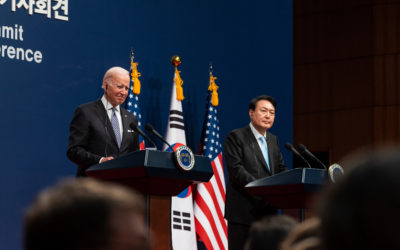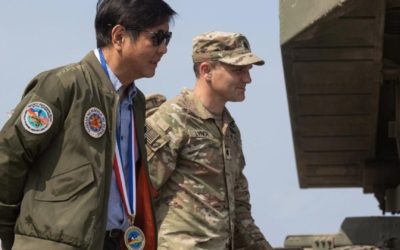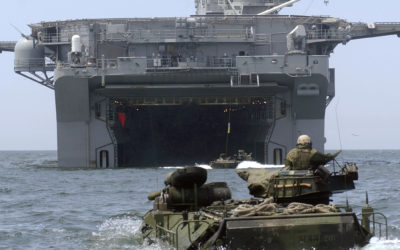On April 26, U.S. President Joe Biden welcomed South Korean President Yoon Suk-yeol to the White House for a summit meeting to celebrate the seventieth anniversary of the U.S.-South Korea alliance and open a new chapter for the next seventy years of expanded cooperation. Amid a substantial list of topics discussed by the two leaders, extended deterrence emerged as the top deliverable.
Finland, NATO and the evolving new world order – what small nations know
Finland, NATO and the evolving new world order – what small nations know
Finland, NATO and the evolving new world order – what small nations know
In the world of geopolitics, great powers make, break and play by their own rules. Smaller states largely have to make do with adjusting to the world as determined by others.
Which is why the decision by Finland – a country of just 5.5 million people, noted for decades as a neutral presence in Europe – to join NATO is so important. It underscores just how the Russian invasion of Ukraine has upset global realities long thought settled, at least by the Western powers.
The vaunted “rules-based order” that the United States and its NATO allies have touted as the best way to run the world is changing – attracting some, yet more suspicious in the eyes of nations not privy to club membership. Meanwhile, Russia and China are disputing the hegemony of the U.S. and the West over global affairs and seek a system in which power is distributed regionally, with Moscow and Beijing holding sway over what they they see as their parts of the world.
Smaller nations all over the globe are recalculating how they fit into this renewed division of the world.
Finland is one such state and has made a dramatic choice. For centuries it has had to consider its own interests in conjunction with – and in accommodation of – those of its gigantic neighbor: czarist Russia, then the Soviet Union and today Vladimir Putin’s Russia. Through the years of the Cold War, Finland adopted a model of neutrality and accommodation in order to coexist with Russia. That way of dealing with a nearby neighboring great power was known as “Finlandization.”
With Russia’s invasion of Ukraine a year ago, decision-makers in Helsinki have seemingly driven the final nails into the coffin of Finlandization. The worry for Putin – and perhaps the West – is that the model has not only been killed off for Finland; it is also dead as a potential off-ramp solution to the conflict in Ukraine.
The past no longer as prologue
After more than a hundred years within the czarist empire, Finland gained its independence in 1917. For the next roughly 20 years it became an anti-Soviet outpost precariously positioned next to the USSR.
Soviet dictator Joseph Stalin saw Finland as a gateway to the communist state’s enemies. In his mind, Finland was an existential threat – similar to how Putin sees Ukraine today.
After annexing eastern Poland and the Baltic states – Estonia, Latvia and Lithuania – after the signing of the German-Soviet Pact of 1939, Stalin demanded serious territorial concessions from Finland.
The resulting war saw the Finns lose much of their eastern provinces, but they managed to preserve their independence – at some cost. The price for maintaining its democratic state and capitalist economy in domestic affairs during the Cold War was Finlandization.
Through the adapted model for neutrality, Finland was able to convince Moscow for more than a half-century that it was no threat but a loyal trading partner.
With the demise of the Soviet Union in 1991, doubts about Finlandization grew among Finns. They debated whether they should consider joining the Western alliance.
But it was Putin’s invasion of Ukraine in 2022 that tipped the scales and finally convinced Helsinki that its security would be enhanced by becoming a member of NATO.
The dilemma of neutrality
The invasion also killed off any idea of Finlandization being a model for post-Soviet Ukraine as well.
For the past 30 years, independent Ukraine was viewed as a problem for Putin, who feared its gravitation toward the West. Similarly, even before the invasion last year, Russia was a problem for Ukraine, with authorities in Kyiv fearing dominance from the East.
Before the present war, the Finnish model of independence and neutrality was touted as a viable alternative to Ukraine joining either NATO or drawing closer to the Russian-led strategic alliance, the Collective Security Treaty Organization.
Finland’s experience in preserving its sovereignty by compromising its right to act completely independently in foreign policy might have been a viable model for former Soviet states, some observers held, especially in regards to Ukraine.
Findlandization might have also, so the thinking went, provided a solution to Ukraine’s internal divisions on the question of which to favor: the West or Russia.
Throughout the 1990s and 2000s, Ukraine swung between a pro-Russian orientation favored in eastern Ukraine, and a more Ukrainian nationalist identity powerfully evident in western Ukraine. A Finlandization of Ukraine, coupled with the federalization of the various provinces of Ukraine, might have lessened political polarization with Ukraine and allayed the fears of the Russians, and Putin in particular.
Of course, history cannot be rewound; such alternative possibilities cannot be tested. And federalism, which would have required that some decision-making be handed to regional governments, was considered suspect as a viable form of statehood by many in Ukraine and Russia alike. A similar process of federalization was, after all, blamed for the breakup of the Soviet Union.
Moreover, events forced Ukraine’s hand. As Russia gravitated toward authoritarianism and used its oil and gas as a weapon against Ukraine, the attractions of the West – democracy, prosperity and a shiny modernity – seemed far more enticing.
On the initiative of the United States, the West vaguely promised Ukraine NATO membership, which Russia found completely unacceptable. And the European Union offered Ukraine closer economic and political ties, stirring up fears in Moscow that this was the first step toward NATO.
After the Russian seizure of Crimea in 2014, Ukrainians turned even more sharply toward the West and became more receptive to Western promises of NATO membership.
‘Small nations can disappear’
In hindsight, hopes that Ukraine could “Finlandize” or federalize were both casualties of Putin’s increasingly hard line toward Ukraine.
Finland’s entry into NATO marks the likely end of the Finlandization model. Even Finland has abandoned it; neutral Sweden is now anxious to join the Western alliance; and other states, even Switzerland, are questioning the efficacy of nonalignment in a polarized world.
In its place, we have the “NATOfication” of Eastern Europe – something that Putin unwittingly accelerated and which leaves Putin’s Russia with less accommodating neighbors. Meanwhile, countries like Finland and Sweden have been left with fewer options. “A small nation can disappear,” the Czech writer Milan Kundera reminds us, “and knows it.”
Republished from The Conversation under a Creative Commons license in order to point Indo-Pacific warfighters and national security professionals to reputable and relevant war studies literature. Read the original article.

Ronald Grigor Suny is the William H. Sewell Jr. Distinguished University Professor of History at the University of Michigan, Emeritus Professor of Political Science and History at the University of Chicago, and Senior Researcher at the National Research University – Higher School of Economics in Saint Petersburg, Russia. The grandson of the composer and ethnomusicologist Grikor Mirzaian Suni and a graduate of Swarthmore College and Columbia University, he taught at Oberlin College (1968-1981), as visiting professor of history at the University of California, Irvine (1987), and Stanford University (1995-1996). He was the first holder of the Alex Manoogian Chair in Modern Armenian History at the University of Michigan (1981-1995), where he founded and directed the Armenian Studies Program. He was Charles Tilly Collegiate Professor of Social and Political History at the University of Michigan from 2005 to 2015 and director of the Eisenberg Institute of Historical Studies from 2009 to 2012.
He is the author of The Baku Commune, 1917-1918: Class and Nationality in the Russian Revolution (Princeton University Press, 1972); Armenia in the Twentieth Century (Scholars Press, 1983); The Making of the Georgian Nation (Indiana University Press, 1988, 1994); Looking Toward Ararat: Armenia in Modern History (Indiana University Press, 1993); The Revenge of the Past: Nationalism, Revolution, and the Collapse of the Soviet Union (Stanford University Press, 1993); The Soviet Experiment: Russia, the USSR, and the Successor States (Oxford University Press, 1998, 2011); and “They Can Live in the Desert But Nowhere Else:” A History of the Armenian Genocide (Princeton University Press, 2015). He is also the editor of Transcaucasia, Nationalism and Social Change: Essays in the History of Armenia, Azerbaijan, and Georgia (Michigan Slavic Publications, 1983; University of Michigan Press, 1996) The Structure of Soviet History: Essays and Documents (Oxford University Press, 2003, 2013), and The Cambridge History of Russia, III: The Twentieth Century (Cambridge: Cambridge University Press, 2006); and co-editor of Party, State, and Society in the Russian Civil War: Explorations in Social History (Indiana University Press, 1989); The Russian Revolution and Bolshevik Victory: Visions and Revisions (D. C. Heath, 1990); Making Workers Soviet: Power, Culture, and Identity (Cornell University Press, 1994); Becoming National (Oxford University Press, 1996); Intellectuals and the Articulation of the Nation (University of Michigan Press, 1999); A State of Nations: Empire and Nation-making in the Age of Lenin and Stalin (Oxford University Press, 2001); and A Question of Genocide: Armenians and Turks at the End of the Ottoman Empire (New York: Oxford University Press, 2011). He is currently working on a co-authored history of Russia entitled Russia’s Empires; a two-volume biography of Stalin; and a series of historiographical essays on Soviet history.
Professor Suny’s intellectual interests have centered on the non-Russian nationalities of the Russian Empire and the Soviet Union, particularly those of the South Caucasus (Armenia, Azerbaijan, and Georgia). The “national question” was an area of study that was woefully neglected for many decades until peoples of the periphery mobilized themselves in the Gorbachev years.
His aim has been to consider the history of imperial Russia and the USSR without leaving out the non-Russian half of the population, to see how multi-nationality, processes of imperialism and nation-making shaped the state and society of that vast country. This in turn has led to work on the nature of empires and nations, studies in the historiography and methodology of studying social and cultural history, and a commitment to bridging the often-unbridgeable gap between the traditional concerns of historians and the methods and models of other social scientists.
Related Articles
President Marcos Jr. Meets With President Biden—But the U.S. Position in Southeast Asia is Increasingly Shaky
Over a four-day visit to Washington, Philippine President Ferdinand Marcos Jr. has been welcomed to the White House and generally feted across Washington. With President Biden, Marcos Jr. (whose father was forced out of office in part through U.S. pressure, and whose family has little love for the United States) affirmed that the two countries are facing new challenges, and Biden said that “I couldn’t think of a better partner to have than [Marcos Jr.].”
The U.S. is about to blow up a fake warship in the South China Sea—but naval rivalry with Beijing is very real and growing
As part of a joint military exercise with the Philippines, the U.S. Navy is slated to sink a mock warship on April 26, 2023, in the South China Sea.
The live-fire drill is not a response to increased tensions with China over Taiwan, both the U.S. and the Philippines have stressed. But, either way, Beijing isn’t happy – responding by holding its own staged military event involving actual warships and fighter jets deployed around Taiwan, a self-governed island that Beijing claims as its own.



